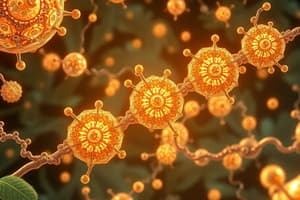Podcast
Questions and Answers
Wat is de rol van enzymen in chemische reacties?
Wat is de rol van enzymen in chemische reacties?
- Ze veranderen het substraat in een ander substraat
- Ze verhogen de activeringsenergie van het systeem
- Ze verminderen de activeringsenergie van het systeem (correct)
- Ze stabiliseren de reactiesnelheid
Hoe wordt de activiteit van enzymen gereguleerd?
Hoe wordt de activiteit van enzymen gereguleerd?
- Door de grootte van het substraat
- Door de vorm van het substraat
- Door factoren zoals substraatconcentratie, enzymconcentratie, temperatuur en pH (correct)
- Door de kleur van het substraat
Wat gebeurt er met de reactiesnelheid wanneer een enzym verzadigd is met substraat?
Wat gebeurt er met de reactiesnelheid wanneer een enzym verzadigd is met substraat?
- Het neemt toe
- Het neemt af
- Het wordt onvoorspelbaar
- Het blijft constant (correct)
Wat is het effect van temperatuur op enzymactiviteit?
Wat is het effect van temperatuur op enzymactiviteit?
Wat gebeurt er met enzymactiviteit wanneer de pH buiten het optimale bereik ligt?
Wat gebeurt er met enzymactiviteit wanneer de pH buiten het optimale bereik ligt?
Wat is het gevolg van competitieve remming op de reactiesnelheid van een enzym?
Wat is het gevolg van competitieve remming op de reactiesnelheid van een enzym?
Wat is het kenmerk van non-competitieve remming met betrekking tot Km en Vmax?
Wat is het kenmerk van non-competitieve remming met betrekking tot Km en Vmax?
Wat is het effect van uncompetitieve remming op de vorming van een ternair complex?
Wat is het effect van uncompetitieve remming op de vorming van een ternair complex?
Hoe kunnen factoren zoals substraatconcentratie, enzymconcentratie en temperatuur de kinetiek van enzymreacties beïnvloeden?
Hoe kunnen factoren zoals substraatconcentratie, enzymconcentratie en temperatuur de kinetiek van enzymreacties beïnvloeden?
Wat is het primaire kenmerk van een enzymstructuur met betrekking tot de actieve plaats?
Wat is het primaire kenmerk van een enzymstructuur met betrekking tot de actieve plaats?
Flashcards are hidden until you start studying
Study Notes
Enzymes: Function, Regulation, Inhibition, Kinetics, and Structure
Enzymes are biological catalysts that play a crucial role in speeding up chemical reactions without being used up in the process. They are highly specific and only bind certain substrates for a particular reaction, which takes place at the active site of the enzyme. This article will discuss the function, regulation, inhibition, kinetics, and structure of enzymes.
Enzyme Function
Enzymes lower the activation energy of a system by making it energetically easier for a reaction to occur. They bind to the substrate and facilitate the conversion of the substrate into a product. This stabilization speeds up reaction rates and makes them happen at physiologically significant temperatures.
Enzyme Regulation
Enzyme activity can be regulated by various factors, including:
- Substrate concentration: The rate of enzyme-catalyzed reactions increases with an increase in substrate concentration until the enzyme is saturated with substrate.
- Enzyme concentration: The rate of the reaction increases with an increase in enzyme concentration.
- Temperature: Enzyme activity increases with an increase in temperature until the enzyme is denatured.
- pH: Enzyme activity changes with pH, and enzymes usually have an optimum pH for maximum activity.
Enzyme Inhibition
Enzyme inhibitors are molecules that decrease the activity of an enzyme. They can be classified into three types: competitive, non-competitive, and uncompetitive inhibitors.
- Competitive inhibition: Occurs when the inhibitor binds to the active site of an enzyme, preventing the substrate from binding. This results in a lower reaction rate.
- Non-competitive inhibition: Occurs when the inhibitor binds to a site other than the active site, increasing the Km but not affecting the Vmax.
- Uncompetitive inhibition: Occurs when the inhibitor binds to the enzyme-substrate complex, forming a ternary complex that prevents the reaction from proceeding.
Enzyme Kinetics
Enzyme kinetics is the study of factors that determine the speed of enzyme-catalyzed reactions. The Michaelis-Menten equation is often used to describe enzyme kinetics, which relates the reaction rate (V) to the enzyme concentration, substrate concentration, and other factors. The kinetics of enzyme reactions can be influenced by factors such as substrate concentration, enzyme concentration, and temperature.
Enzyme Structure
Enzymes are proteins with a globular tertiary structure. The active site, where the reaction occurs, is a small cleft within the enzyme with a specific amino acid structure. The enzyme's structure is highly specific to the reaction it catalyzes, and the reactants involved. The rest of the enzyme acts as a scaffold, providing stability to the active site.
In conclusion, enzymes are essential components of cells, catalyzing various chemical reactions and regulating their rates. Their function, regulation, inhibition, kinetics, and structure can be understood through the lens of modern biochemistry.
Studying That Suits You
Use AI to generate personalized quizzes and flashcards to suit your learning preferences.




